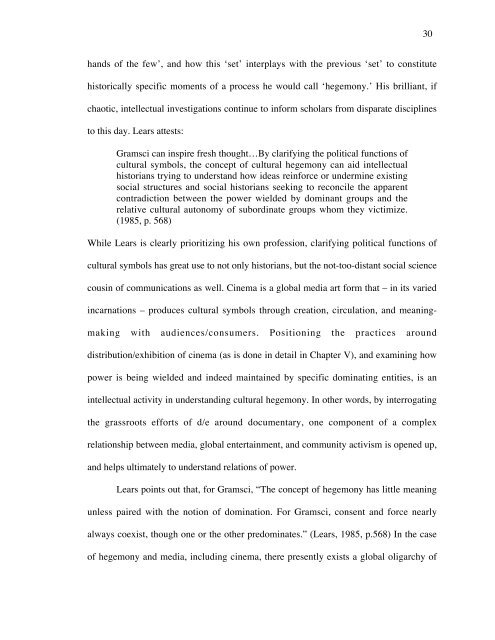The Spaces Between Grassroots Documentary ... - Ezra Winton
The Spaces Between Grassroots Documentary ... - Ezra Winton
The Spaces Between Grassroots Documentary ... - Ezra Winton
You also want an ePaper? Increase the reach of your titles
YUMPU automatically turns print PDFs into web optimized ePapers that Google loves.
hands of the few’, and how this ‘set’ interplays with the previous ‘set’ to constitute<br />
historically specific moments of a process he would call ‘hegemony.’ His brilliant, if<br />
chaotic, intellectual investigations continue to inform scholars from disparate disciplines<br />
to this day. Lears attests:<br />
Gramsci can inspire fresh thought…By clarifying the political functions of<br />
cultural symbols, the concept of cultural hegemony can aid intellectual<br />
historians trying to understand how ideas reinforce or undermine existing<br />
social structures and social historians seeking to reconcile the apparent<br />
contradiction between the power wielded by dominant groups and the<br />
relative cultural autonomy of subordinate groups whom they victimize.<br />
(1985, p. 568)<br />
While Lears is clearly prioritizing his own profession, clarifying political functions of<br />
cultural symbols has great use to not only historians, but the not-too-distant social science<br />
cousin of communications as well. Cinema is a global media art form that – in its varied<br />
incarnations – produces cultural symbols through creation, circulation, and meaning-<br />
making with audiences/consumers. Positioning the practices around<br />
distribution/exhibition of cinema (as is done in detail in Chapter V), and examining how<br />
power is being wielded and indeed maintained by specific dominating entities, is an<br />
intellectual activity in understanding cultural hegemony. In other words, by interrogating<br />
the grassroots efforts of d/e around documentary, one component of a complex<br />
relationship between media, global entertainment, and community activism is opened up,<br />
and helps ultimately to understand relations of power.<br />
Lears points out that, for Gramsci, “<strong>The</strong> concept of hegemony has little meaning<br />
unless paired with the notion of domination. For Gramsci, consent and force nearly<br />
always coexist, though one or the other predominates.” (Lears, 1985, p.568) In the case<br />
of hegemony and media, including cinema, there presently exists a global oligarchy of<br />
30


